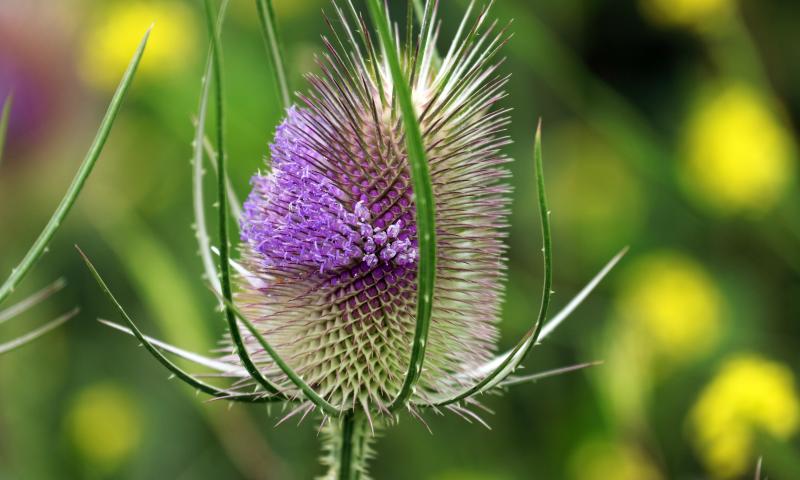 />
/>
Teasel (Dipsacus fullonum) is a plant that has captured the interest of botanists, historians, and herbal enthusiasts for centuries. With its distinctive botanical characteristics and rich history, it stands out in the flora where it grows. This article aims to delve into the botanical intricacies of teasel, its chemical makeup, historical significance, taste profile, and the general health benefits it is believed to offer, as well as its traditional indications for use.
Botanical Characteristics:
Teasel is a biennial plant belonging to the Dipsacaceae family, which is native to Europe, North Africa, and some parts of Asia. It is characterized by its tall stature, reaching up to two meters in height, and its prickly stem and leaves. The leaves are oppositely arranged along the stem, conjoining at the base to form a cup-like structure that often collects water. Its most notable feature is the egg-shaped head with spiny bracts that bloom into small lavender to white flowers in its second year. The flowers are hermaphroditic, attracting a wide array of pollinators through their nectar.
Chemical Composition:
Teasel's chemical profile is intriguing, comprising a variety of compounds that contribute to its traditional uses. Flavonoids, iridoids, and tannins are among the primary constituents. The presence of these compounds suggests that teasel has antioxidative properties, although the full extent of its phytochemistry is yet to be exhaustively studied.
Historical Facts:
Historically, teasel has had a multifaceted role in human activities. The dried heads of the plant were once widely used in textile processing to raise the nap on fabrics, a process known as 'teasing'. This historical use is so significant that it has influenced the common name of the plant. In traditional folk practices, teasel was revered for various purposes, including use in certain rituals and ceremonies. Its role in folklore is often as intriguing as its physical appearance.
Taste:
The taste of teasel root, which is the most commonly used part of the plant, is described as slightly bitter with an earthy undertone. This flavor profile makes it a challenging standalone herb in culinary applications, hence it is rarely used for cooking. However, the taste is often not a barrier for its use in traditional herbal preparations, where it is usually infused into teas or tinctures.
General Health Benefits:
Teasel is celebrated for its general health-promoting properties. It is often associated with supporting the body's natural inflammatory response and promoting vitality and well-being. The herb is also noted for its potential to support the body's connective tissues. Its antioxidant properties suggest that it may help in maintaining healthy skin and supporting the body's natural healing processes.
Indications for Use:
In traditional settings, teasel is indicated for a variety of non-medical purposes. It may be used by herbalists to support general physical resilience and to promote natural recovery from fatigue. Additionally, it is sometimes used in practices aimed at supporting joint and muscle comfort, especially related to overexertion. Teasel root preparations are also traditionally indicated for use as a tonic to promote overall well-being.
Conclusion:
While the full spectrum of teasel’s benefits and applications are yet to be confirmed by modern science, there is no doubt that Dipsacus fullonum has played a significant role in historical and traditional contexts. Its unique botanical characteristics, chemical composition, and the legacy of its uses invite further research and appreciation. Whether admired in the wild for its spiky elegance or utilized in traditional herbal practices, teasel continues to be a plant of fascination and potential utility.
